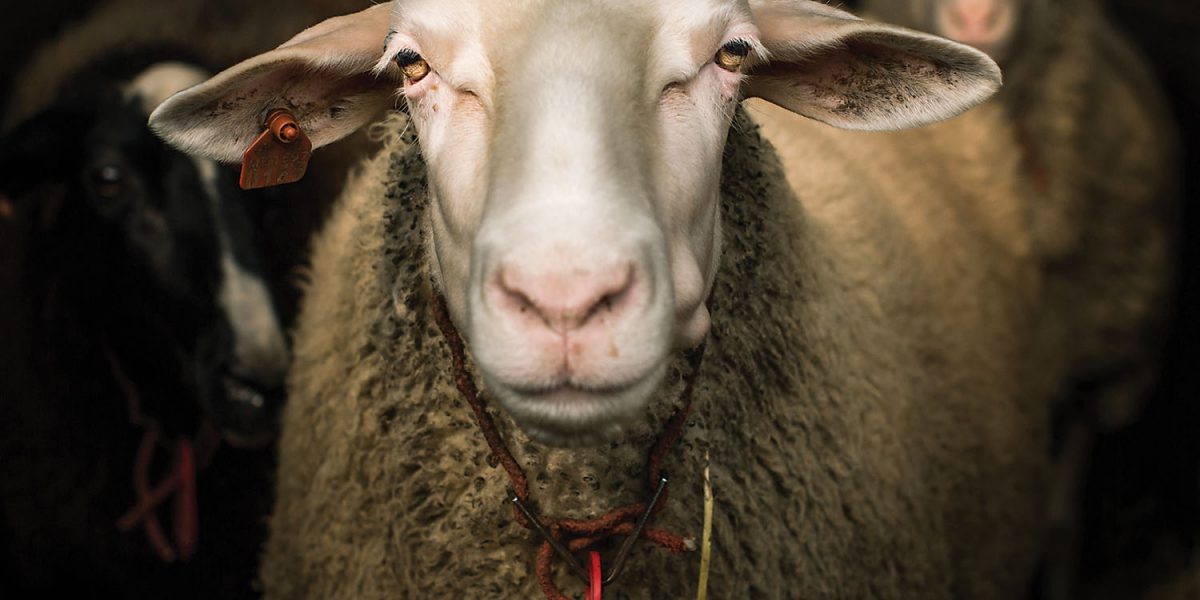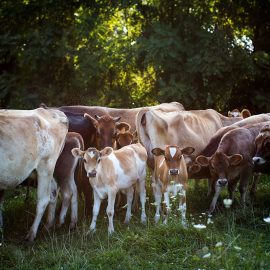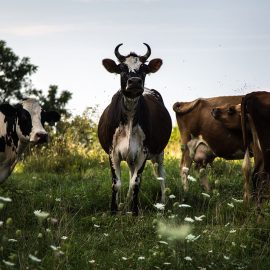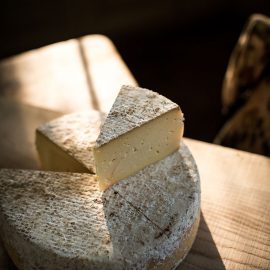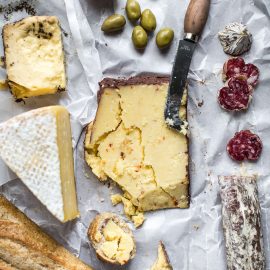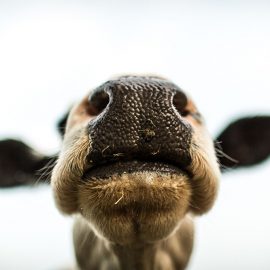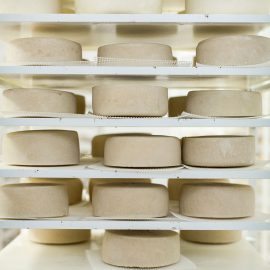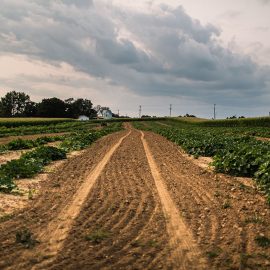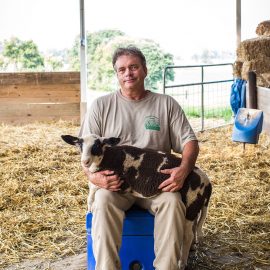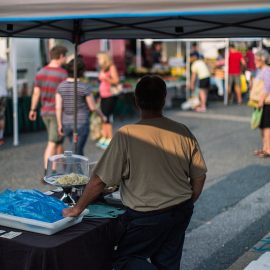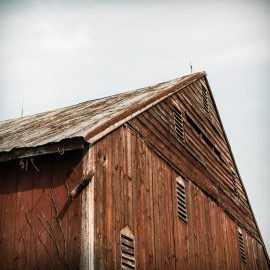Food & Drink
Say Cheese!
The Maryland cheesemaking scene begins to ripen.
Sheep have a reputation as followers, and Dottie is no exception, standing patiently in line, skittering up the steel ramp, and taking a sharp left into a stall at Shepherds Manor Creamery in Carroll County. Her front end makes quick work of a cracked barley and molasses breakfast while dairy owner Colleen Histon, stationed behind her fuzzy hind-end, sees to the milking. Dottie's quart or so of warm, creamy milk is pumped from the milking parlor through a cooling tank to the processing room. Here, Colleen and Michael Histon work their alchemy—turning sweet, ephemeral milk into the complex, long-lasting miracle called cheese.
"It's amazing that these few ingredients come together as cheese," says Colleen Histon, who since 2011 has been honing her recipes for salty Fetina, earthy Tomae, and mild Colbere. She remembers the first time she and her husband, Michael, made cheese. "We were elated," she says.
With good reason. Cheesemaking is a tricky business—equal parts science, art, and even politics—and suddenly on trend. Maryland has 26 cheesemakers—exactly 24 more than a decade ago. This new cheesiness is the product of many pressures—consumers' hunger for farm-to-table authenticity, farmers' efforts to innovate, and government cheese reform. Now, thanks to a program that expands cheesemaking and some award-winning cheesemakers, Maryland can see the future—and it's delicious.
In 2004, Holly and Eric Foster settled on the idea of making cheese on their 112-acre property in Easton. And, like artisan cheesemakers in Europe, they wanted to make it from raw (unpasteurized) milk. "It's one of the best, whole, all-natural foods you can eat—or drink," says Holly. Once that "un-messed with" raw milk is made into raw-milk cheese, says Holly, "there's so much more flavor; it's more complex."
In Maryland, it's illegal to sell raw milk, due to concerns that it harbors pathogens. When the Fosters started out, making cheese from raw milk was also illegal. But selling it was not. So the Fosters drove the so-called "cheese trail," hauling their milk to Pennsylvania where it could legally be made into cheese, then bringing it back to sell at Chapel's Country Creamery.

In the fall of 2006, Holly was asked to put together a cheese table for a fundraiser attended by local politicians, including state Senator Richard F. Colburn. She set out her Talbot Reserve, Chapel Cheddar, a garlic and chive cheddar, and her mushroomy Chapelle.
The politicos liked the spread—and they liked that it was local. "I said, 'You have to understand, I'm not allowed to make this cheese in the state of Maryland,'" says Holly. "They were all appalled."
That conversation—as well as many more in Annapolis—lead the Maryland Department of Health and Mental Hygiene to establish the Farmstead Cheese Pilot Study Program in 2007. At first, Chapel's Country Creamery was the only farm in the study; two others earned permits later. In 2009, thanks to the pilot program, Holly cooked up Maryland's first legal batch of raw-milk cheese: the pungent Bay Blue. "It was a thrilling moment," she says.
"The milk doesn't leave here now," she says. "We milk in the morning and it goes into the vat warm and fresh. It's a wheel of cheese by the end of the day." The process, she says, defines artisan. "What you need is good milk, small batches, and a good recipe. You just add your love to it."
Her efforts paid off. In 2013, Maryland made the program permanent joining 45 other states that permit farmers to produce raw-milk cheese. But there are limits: Only hard cheeses, only with milk from one herd, only with a permit, and only under strict regulations for testing, record-keep, labeling, and safety procedures. Hardly the end of Prohibition, but possibly the start of a local cheese culture. The state now has 15 cheesemakers that ship milk out-of-state (DIY takes a lot of work—and investment), eight that make cheese in-state from pasteurized milk (in which the milk is first heated to kill off bacteria), and three raw-milk farmstead producers. Not bad for a recently cheese-free state. "It's terrific for the region and for the state," say Mike Koch, president of FireFly Farms Creamery and Market in Garrett County. "It's helping develop an original identity for Mid-Atlantic cheesemaking and cheeses."
Maryland has 26 cheesemakers—24 more than a decade ago.
Cheese reform was designed to help save the dairy farm. At last count, the state had just 452 dairy farms, down by more than 1,000 over the past 20 years. Allen Galbreath was determined to hang onto his.
Galbreath loves cows. So in 1990, when he and his wife Kim married and settled into Hawks Hill, the Harford County farm that's been in his family since 1924, he had a dream: Raise cows; sell milk.
Cows were rewarding, but milk was not, largely because prices are set by something called Federal Milk Marketing Orders. "Dairy farmers work 24-7 and they make nothing," says Kim. It was Kim, with her MBA, who figured out how to hold onto the family farm: diversify. They dug in a pumpkin patch, learned to churn ice cream, and, in 2004, tried cheese.
The Galbreaths wanted to start with raw milk "the way it came from the cow," says Allen. And not just any cow, but one like Ethel, their big-eyed 2,000-pound beauty whose Holstein speckle includes a splotch in the shape of a heart. Given the laws at the time, the Galbreaths rode the cheese trail, delivering raw milk to Israel Kinsinger, who's been pressing cheese in Pennsylvania's Lancaster County for most of his 42 years.
Kinsinger's cheese house is a one-story gray building. It's quiet in the sour chill—no computer hum or gadget buzz. "We generally don't tap electricity off the line," Kinsinger says. He does run a generator. It's a compromise, a way to balance the demands of business with the technology-averse traditions of the Amish. "We are still trying to maintain our self-sufficiency," he says.
Two stainless-steel tanks dominate the production room—a rectangular cheesemaking vat that can hold 900 gallons of milk and an oval finishing vat that resembles an over-sized bathtub. Here the milk is warmed, then mixed with enzyme (a liquid) and starter culture (a powder). It's culture—live bacteria—that helps give cheeses their signature flavors and ripen the cheese.

Kinsinger peers into the finishing vat. The enzyme has done its work, coagulating the milk into a slurry of lumps (curd) and liquid (whey). He checks the pH, records the results at his roll-top desk, and then drains the liquid. The remaining curd looks like lightly buttered popcorn and tastes like warm, squeaky, nothing.
Another few hours of turning and the delicate cheddar curds are ready to be pressed overnight into springy 40-pound blocks. With the help of son Stephen, 17, Kinsinger bags, seals, boxes, and labels the blocks. He lets them ripen at room temperature for 48 hours, and then loads them into the cooler to age. "The cheesemaking process," says Kinsinger, "is a long process."
By law, the cheese must age at least 60 days; which, much like pasteurization, kills off bacteria. Cheddar takes anywhere from four months to two—or more—years. The trick is knowing when a batch has reached its peak. Every month or two, Kinsinger pulls a plug. "We taste it," he says. "We look to see if it has a deep cheddar flavor. At two to three years, it gets a caramel flavor. It could be a little sweet, like chocolate. It could have some bitterness or some fruitiness, like an apple."
When Allen Galbreath picked up his first brick of cheddar, it was a revelation. "It was the first time I was able to hand someone a product [entirely] from my farm," he says. That first year, a Harford County liquor store stocked Hawks Hill. Then Klein's ShopRite wanted in. Then Graul's, Eddie's of Roland Park, Whole Foods, and by 2009, Woodberry Kitchen.
"Maryland customers are incredibly educated about cheese," says Monika Thompson, who plans to add local flavor to Wegman's 200-plus linear feet of cheese in the near future. "They know what they want." One thing aficionados want is a product that tastes uniquely of the place it was created. Foodies and oenophiles call this ideal terroir, French for homeland.
At Cedar Hill Farm in Harford County, the land is lush and hilly. Here Barbara and Michael Connell raised six girls and one boy, as well as horses, sheep, and goats, but it wasn't until 1998 that they raised their first dairy calf, a Jersey named Nellie. "She was adorable, so sweet," says daughter Abigail Connell, now 26. Barbara Connell was intrigued by an article she'd read about a New Jersey cheesemaker who milked his cows just once a day and fed them not grain, but grass.

In 2006, Abigail and her twin sister, Cora, apprenticed to that cheesemaker, Jonathan White. "I was quite shocked the first day," says Abigail. The "odd loaves and cakes" looked nothing like Kraft Singles. "By the second day it was, 'This is the best cheese I've ever had.'" In 2010, Abigail returned home with a vision: "Farmstead cheese," she decided. "This is what I want to do. And I want to bring it back to Maryland."
By then, Nellie and some 100 companions grazed Cedar Hill's 82 acres of meadows along Deer Creek. The family sold part of the herd to fund a parlor (for milking), a creamery (for cheese-making), and Maryland's first cheese cave (for aging). They carved into a hill near the farm's 200-year-old barn, shaping three aging rooms, one brining room, and one wrapping room, each smoothly coated in cement—and empty. Capital spent, Cedar Hill will launch a Kickstarter campaign this month to help fund and finish the project.
For now the Connells rely on the cheese trail—shipping raw milk to Pennsylvania, and getting back a hole-speckled tomme-style cheese called Meadow and a nutty Alpine-style called Deer Creek, among others. The family has plans for a creamy Camembert, named after that first calf, Nellie. One Saturday at a farmers' market, Barbara Connell offered a sample to a "Fells Point yuppie." "I remember tasting those grass flavors," says Levi Briggs, then executive chef at Waterfront Kitchen. "I shocked Barb by saying, 'I'll take the whole wheel.'" Now, Cedar Hill cheeses are featured on area menus.
"There's a lot of innovation happening."
Maryland cheeses are finding their home in the market as well. "There's a lot of innovation happening," says Kari Nye, who runs the cheese department in the market attached to Parts & Labor. She's particularly fond of Cabra LaMancha, a Manchego-Tallegio hybrid, made by FireFly Farms. "They're putting their own spin on it. You won't find that kind of cheese anywhere else."
FireFly's seven cheeses—from tangy Allegheny Chèvre to ash-coated Bûche Noire—are made from pasteurized goat's milk. That's because when the dairy first opened, it had no choice. "The regulation environment in Maryland is strict," says Koch. While pasteurization may kill off some flavor, Koch looks at it more like preparing a smooth canvas. "We work doubly hard to reintroduce a lot of 'color.' Some of our cheeses contain as many as a half-dozen separate starter cultures, known for positively contributing to flavor and texture and the ability of a cheese to ripen in a healthy, positive way. We take that part of cheesemaking seriously."
And they get serious results. FireFly has racked up dozens of honors, including a gold medal at the World Cheese Awards. Last year at the annual American Cheese Society Judging & Competition, FireFly won first- and third-place ribbons. P. A. Bowen Farmstead, in Price George's County, also took a third.
Adhering to the state's strict code has also been good for business, says Koch. "For years, I thought the best thing I could have done is start [FireFly] 15 minutes to the north, in Pennsylvania, where there's a lot less state regulation. I've come full circle. What we were required to do in Maryland—making things bullet-proof from a hygenic persective, having an inspector we knew was going to be there frequently, the focus on record-keeping—has positioned us to grow and manage relationships with big supermarkets that require good management practices. I'm happy I did it in Maryland now. Go figure."
The Wheel World 
Some of Maryland's most popular cheesemakers may be closer than you think.
FireFly Farms Creamery and Market
107 South Main Street
Accident, MD 21520
301-746-8188
Cheeses Made: Seven pasteurized goat's milk cheeses include Allegheny Chèvre, Bûche Noire, Merry Goat Round, Mountain Top Bleu, and Cabra La Mancha.
Where to Find Them: Atwater's Bakery, Eddie's of Roland Park, MOM's Organic Market, Whole Foods Market, Woodberry Kitchen.
P.A. Bowen Farmstead
15701 Doctor Bowen Road
Brandywine, MD 20613
301-579-2727
Cheeses Made: Raw cow's milk cheeses include Prince George's Blue, Chesapeake cheddar, Dreamy Creamy, and Aged Jack.
Where to Find Them: P. A. Bowen Farmstead Store, Woodberry Kitchen.
Cherry Glen Goat Cheese co.
16120 Barnesville Road
Boyds, MD 20841
301-580-8037
Cheeses Made: Pasteurized goat's milk cheeses include Cherry Glen Chèvre, ricotta, and five soft-ripened cheeses: Monocacy
Crottin, Silver, Ash, Chipotle, and Gold.
Where to Find Them: Atwater's Bakery, b bistro, Eddie's of Roland Park, Whole Foods Market, The Wine Source.
Broom's Bloom Dairy
1700 South Fountain Green Road
Bel Air, MD 21015
410-399-2697
Cheeses Made: Cow's milk cheeses include a Colby and various cheddars including smoked, Chesapeake, garlic-chive, and Italian.
Where to Find Them: Bel Air Farmers' Market, 32nd Street Market.
Online Exclusive Images
